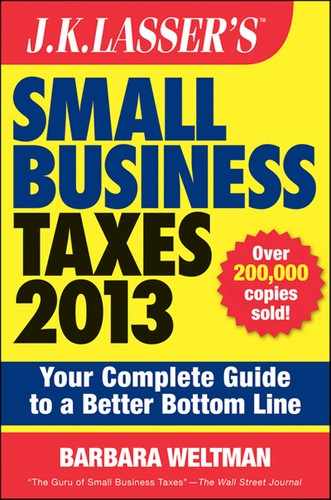Certain Disaster Victims
NOTE
For links to disaster assistance and emergency relief for businesses, go to www.irs.gov and search “disaster assistance and emergency relief for individuals and businesses.”
If your business is located in an area affected by certain storms, or other federal disasters, you may be eligible for special tax breaks. These include additional time for filing certain returns and paying certain taxes, increased write-offs for certain property purchases (intended to restore the area following the disaster), and an extended net operating loss carryback. These breaks are discussed in relevant sections throughout this book.
Where to Deduct Casualty and Theft Losses and Related Items
Employees
Casualty and theft losses to business property are calculated in Section B of Form 4684, Casualty and Theft Worksheet for Individuals. Losses are then netted against gains and are entered on Form 4797, Sales of Business Property. Your losses are entered directly on page 1 of Form 1040. They are not taken on Schedule A, as are casualty and theft losses to personal property (such as your personal residence). Nor are they limited by the $100 per casualty or 10%-of-adjusted-gross-income limitation that applies to casualty and theft losses to nonbusiness property.
If the casualty or theft happened to property used for both business and personal purposes, you must make an allocation. Only the business portion of the loss is free from the $100/10% limitations. For example, if you use a car 75% for business and 25% for personal purposes and the car is totaled in an accident for which you do not have collision insurance, 75% of your loss (the business portion) is claimed without regard to the $100/10% limits; the other 25% of your loss (the personal portion) is subject to both the $100 and 10% limits.
Self-Employed
Casualty and theft losses to business property are calculated in Section B of Form 4684. Losses are then netted against gains and are entered on Form 4797. The net result is then entered on page 1 of Form 1040; you do not enter the amount on Schedule C.
Losses from involuntary conversions are netted against gains and losses from Section 1231 property. This is essentially depreciable property, used in a trade or business and held for more than 1 year, that is not held for inventory or for sale to customers in the ordinary course of business. (Certain livestock, crops, timber, coal, and domestic iron ore can also be Section 1231 property.) Thus, even if you have a casualty loss, you may not get the benefit of the loss if you have gains from the sale or exchange of Section 1231 property. However, losses to inventory are taken into account in the cost of goods sold.
Partnerships and LLCs
The partnership or LLC reports income or loss from an involuntary conversion (casualty, theft, or condemnation) on Form 4797. The net gain or loss is taken into account when arriving at the total trade or business income or loss on Form 1065 on the specific line provided for net gain or loss from Form 4797.
Even if you are a silent partner in an activity that is treated as a passive activity, casualty and theft losses are not subject to the passive loss limitations. You may claim these losses as long as they are not a recurrent part of the business.
S Corporations
If the S corporation has income or loss from an involuntary conversion (casualty, theft, or condemnation), it must file Form 4797. The net gain or loss is taken into account in arriving at the S corporation’s total trade or business income or loss on Form 1120S. Net gain or loss from Form 4797 is reported on the specific line provided on Form 1120S for this purpose.
Even if you are a silent partner in an activity that is treated as a passive activity (a shareholder who does not materially participate in the business), casualty and theft losses are not subject to the passive loss limitations. You may claim these losses as long as they are not a recurrent part of the business.
C Corporations
C corporations report net gains or losses from involuntary conversions on Form 4797 and then use the net amount to arrive at taxable income on Form 1120. Net gains or losses from Form 4797 are reported on the specific line provided on Form 1120 for this purpose.
..................Content has been hidden....................
You can't read the all page of ebook, please click here login for view all page.
